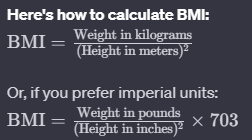Just as we track our investments and returns, it’s crucial to monitor our fitness progress. Today, I want to explore how Body Mass Index (BMI) can be a useful tool in setting and tracking fitness goals.
Understanding BMI
BMI is a simple calculation using height and weight to categorize individuals into different weight categories: underweight, normal weight, overweight, and obese.

Setting Fitness Goals with BMI
When I embarked on my fitness journey, BMI was a starting point. It gave me an idea of where I stood and what I needed to work towards. Here’s how you can use BMI to set your fitness goals:
1. Identify Your Current Category
Knowing whether you’re underweight, normal weight, overweight, or obese provides a clear starting point.
2. Set a Target Category
Aim for a healthy BMI range. If you’re overweight, your initial goal might be getting into the ‘normal’ category.
3. Tailor Your Fitness Plan
Depending on your BMI category, your approach to fitness will vary. Higher BMIs might require more cardio and dietary changes, while lower BMIs could call for strength training and a calorie-rich diet.
Tracking Progress
Regular Check-Ins
Just like reviewing financial statements, regular BMI check-ins are essential. They help you track your progress and make necessary adjustments to your fitness plan.
Beyond BMI: Other Metrics
While BMI is a useful tool, it has limitations. It doesn’t account for muscle mass, bone density, or overall body composition. Therefore, complement BMI with other measurements like waist circumference, body fat percentage, and fitness tests.
Personal Experience
In my journey, I found that aligning my fitness goals with my BMI was effective in the initial stages. As I progressed, I started incorporating other measures and listening to my body. Fitness, like finance, is not just about the numbers; it’s about how you feel and function.
Conclusion
BMI is a valuable tool in setting and tracking fitness goals, especially for beginners. It provides a clear framework to start and measure progress. However, it’s important to remember that it’s just one aspect of a multifaceted approach to health and fitness. Like in personal finance, diversification and a holistic view are key to long-term success.
Remember, your health is an investment, and just like any good investment, it requires time, effort, and regular monitoring. Stay motivated, stay informed, and let those numbers guide you towards your fitness ambitions!
Leave a Reply